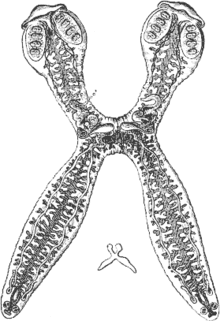- Diplozoon paradoxum
-
Diplozoon paradoxum 
Scientific classification Kingdom: Animalia Subkingdom: Eumetazoa (unranked): Bilateria Superphylum: Platyzoa Phylum: Platyhelminthes Class: Trematoda Subclass: Monogenea Order: Polyopisthocotylea Family: Diplozoidae Genus: Diplozoon Species: D. paradoxum Binomial name Diplozoon paradoxum
Nordmann, 1832Diplozoon paradoxum is a monogenoidea found in freshwater fishes in Asia and Europe that is known to have complete monogamy. This parasite is commonly found on the gills of European cyprinid fishes. Its size is usually around 0.7 centimeters (approximately the size of a fingernail). It is a platyhemith and has several hooks at its mouth which it will use to grab on to the gills of a fish. From there it will feed on the blood of a Cyprinid. Cyprinids are smaller fish that include the goldfish. They (Diplozoon Paradoxum) have bilateral symmetry. They exhibit strong seasonal variation in their reproductive activity. Unlike most parasites that produce gametes all year, paradoxum gametes are produced primarily during the spring, with the highest production from May to June and continuing through the rest of the summer. The eggs of the Diplozoon paradoxum are laid in a fresh water fish's gills. There it hatches into a larva stage (diporpa). It will remain in that stage unless two larvae come together. Then the two larvae will undergo metamorphosis and become fused together.
Life cycle
The life cycle of the D. paradoxum is unique. A diporpa juvenile can live for several months, but it cannot develop further until encountering another diporpa; unless this happens, the diporpa usually will die. When one diporpa finds another, each attaches its sucker to the dorsal papilla of the other. This begins one of the most intimate associations of two individuals of the animal kingdom. The two worms fuse completely, with no trace of partitions separating them. The fusion stimulates maturation. Gonads appear; the male genital duct of one terminates near the female genital duct of the other, permitting cross-fertilization. Two more pairs of clamps develop in the opisthaptor of each. Adults apparently can live in this state for several years.
Here is excerpt from a New York Times article:
"Diplozoon paradoxum are hermaphroditic flatworms that live on gills of freshwater fishes. Males and females meet each other during their juvenile stage, and their bodies completely fuse together, whereupon they remain faithful until death," Dr. Barash said. Once the two worms have fused together cross-fertilization can be permitted. "That's the only species I know of in which there seems to be 100 percent monogamy.""
References
New York Times, In Most Species, Faithfulness Is a Fantasy [1]
Stewart. "Detailed Taxonomy of the Parasitic Helminths ." Path. Online. 28 January 2008.
"Monogeneans and Acanthocephalans." Aber. Online. 28 January 2008.
Diplozoon Paradoxum." Parasitology. Online. 28 January 2008.
Pioneer Middle School Virtual Zoo http://pioneerunion.ca.schoolwebpages.com/education/components/scrapbook/default.php?sectiondetailid=2788&PHPSESSID=22b198a723c353332b58fb3d7178e0fa
Roberts, Larry S. & Janovy, John Jr., Foundations of Parasitology 7th Ed., 305-306
Categories:- Platyhelminthes
- Parasitic animals
- Invertebrate stubs
Wikimedia Foundation. 2010.
